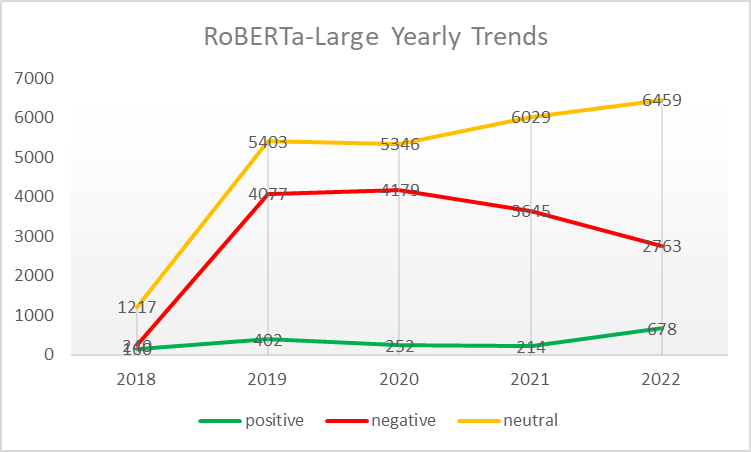A Investigation of Feminism Trends Through Sentiment Analysis Using Machine Learning and Natural Language Processing
Keywords:
Natural Language Processing, Large Language Models, Machine Learning, Sentiment Analysis, Textual data, FeminismAbstract
Introduction/Importance of Study:
One of the recent changes seen in Pakistan is the growing awareness among people, to end gender discrimination and bring equality, across various spheres. “Aurat March”, is a series of rallies that began in 2018 to mark International Women’s Day. People across the nation, comment on these rallies through social media.
Novelty Statement:
The response to the “Aurat March”, held annually since 2018, was mixed and no analysis of Twitter data had been previously done to investigate the polarity of comments, through Machine learning and Natural Language Large Language Models.
Material and Method:
For this, Sentiment analysis was performed, using Machine learning and NLP techniques, on the pre-processed data. Lexical rule-based VADER and transformer-based pre-trained Large Language Models were used to check the polarity of Twitter comments.
Results and Discussion:
The best results were achieved through RoBERTa-LARGE, which were closest to the Human Labelled Data, hence validating the accuracy of the LLM. On the other hand, VADER results were clearly far from the manually labeled results. The sentiment analysis that was applied the first time on “Aurat March” tweets, gave us satisfactory results, and we were further able to validate our research, by comparing the models’ accuracy with human-labeled results. Consequently, by analyzing the sentiments expressed on Twitter, we were able to discern the general mindset of users and gain insights into prevailing trends.
Conclusing Remarks:
This analysis provided us with a reasonably accurate gauge to assess the perception of feminism over the past few years, allowing us to evaluate whether it has garnered fame or faced defamation in the public discourse.
References
A. Sarwar and M. K. Imran, “Exploring women’s multi-level career prospects in Pakistan: Barriers, interventions, and outcomes,” Front. Psychol., vol. 10, no. JUN, p. 444970, Jun. 2019, doi: 10.3389/FPSYG.2019.01376/BIBTEX.
A. Grönlund, “More Control, Less Conflict? Job Demand–Control, Gender and Work–Family Conflict,” Gender, Work Organ., vol. 14, no. 5, pp. 476–497, Sep. 2007, doi: 10.1111/J.1468-0432.2007.00361.X.
“Research Methods For Business Students: Adrian Thornhill / Philip Lewis / Mark N. K. Saunders: 9781292208787: Amazon.com: Books.” Accessed: Mar. 28, 2024. [Online]. Available: https://www.amazon.com/Research-Methods-for-Business-Students/dp/1292208783
S. R. Madsen and R. T. Scribner, “A perspective on gender in management The need for strategic cross-cultural scholarship on women in management and leadership,” Cross Cult. Strateg. Manag., vol. 24, no. 2, pp. 231–250, 2017, doi: 10.1108/CCSM-05-2016-0101/FULL/XML.
“Young Women in Pakistan – Status Report 2020 | UN Women – Asia-Pacific.” Accessed: Mar. 28, 2024. [Online]. Available: https://asiapacific.unwomen.org/en/digital-library/publications/2020/11/young-women-in-pakistan-status-report-2020
J. Acker, “Inequality Regimes,” http://dx.doi.org/10.1177/0891243206289499, vol. 20, no. 4, pp. 441–464, Aug. 2006, doi: 10.1177/0891243206289499.
“Types of Feminism: The Four Waves | Human Rights Careers.” Accessed: Mar. 28, 2024. [Online]. Available: https://www.humanrightscareers.com/issues/types-of-feminism-the-four-waves/
R. F. Baumeister, J. D. Campbell, J. I. Krueger, and K. D. Vohs, “Does High Self-Esteem Cause Better Performance, Interpersonal Success, Happiness, or Healthier Lifestyles?,” Psychol. Sci. Public Interes., vol. 4, no. 1, pp. 1–44, 2003, doi: 10.1111/1529-1006.01431.
A. Vera and D. Hucke, “Managerial orientation and career success of physicians in hospitals,” J. Health Organ. Manag., vol. 23, no. 1, pp. 70–84, 2009, doi: 10.1108/14777260910942560.
“Aurat Azadi March - Wikipedia.” Accessed: Mar. 28, 2024. [Online]. Available: https://en.wikipedia.org/wiki/Aurat_Azadi_March
“Almost 90% of Men/Women Globally Are Biased Against Women | United Nations Development Programme.” Accessed: Mar. 28, 2024. [Online]. Available: https://www.undp.org/press-releases/almost-90-men/women-globally-are-biased-against-women
A. Khurshid and A. Saba, “Contested womanhood: women’s education and (re)production of gendered norms in rural Pakistani Muslim communities,” Discourse Stud. Cult. Polit. Educ., vol. 39, no. 4, pp. 550–563, Jul. 2018, doi: 10.1080/01596306.2017.1282425.
“The future of female doctors”, [Online]. Available: https://www.bmj.com/content/338/bmj.b2223
“The Women’s March and Its Impact, One Year Later | The Brink | Boston University.” Accessed: Mar. 28, 2024. [Online]. Available: https://www.bu.edu/articles/2018/the-womens-march-and-its-impact/
K. Taylor, T. Lambert, and M. Goldacre, “Future career plans of a cohort of senior doctors working in the National Health Service,” J. R. Soc. Med., vol. 101, no. 4, p. 182, Apr. 2008, doi: 10.1258/JRSM.2007.070276.
“What Is Sentiment Analysis (Opinion Mining)? | Definition from TechTarget.” Accessed: Mar. 28, 2024. [Online]. Available: https://www.techtarget.com/searchbusinessanalytics/definition/opinion-mining-sentiment-mining
“Using Transformer-Based Language Models for Sentiment Analysis | by Bogdan Kostić | Towards Data Science.” Accessed: Mar. 28, 2024. [Online]. Available: https://towardsdatascience.com/using-transformer-based-language-models-for-sentiment-analysis-dc3c10261eec
“DATA PREPROCESSING IN SENTIMENT ANALYSIS USING TWITTER DATA.” Accessed: Mar. 28, 2024. [Online]. Available: https://www.researchgate.net/publication/334670363_DATA_PREPROCESSING_IN_SENTIMENT_ANALYSIS_USING_TWITTER_DATA
“Manual or automated data labeling, how to decide?” Accessed: Mar. 28, 2024. [Online]. Available: https://www.labellerr.com/blog/manual-or-automated-data-labeling-how-to-decide/
“Institute of Policy Studies - Institute of Policy Studies.” Accessed: Mar. 28, 2024. [Online]. Available: https://www.ips.org.pk/
S. M. Rao, N. Monica, P. Nikhila, T. Tejasri, and B. Maram, “Positivity Calculation using Vader Sentiment Analyser,” Int. J. Acad. Eng. Res., vol. 4, pp. 13–17, 2020, Accessed: Mar. 28, 2024. [Online]. Available: www.ijeais.org/ijaer
C. J. Hutto and E. Gilbert, “VADER: A Parsimonious Rule-Based Model for Sentiment Analysis of Social Media Text,” Proc. Int. AAAI Conf. Web Soc. Media, vol. 8, no. 1, pp. 216–225, May 2014, doi: 10.1609/ICWSM.V8I1.14550.
X. Gong, W. Ying, S. Zhong, and S. Gong, “Text Sentiment Analysis Based on Transformer and Augmentation,” Front. Psychol., vol. 13, p. 906061, May 2022, doi: 10.3389/FPSYG.2022.906061/BIBTEX.
“Transformers Explained Visually (Part 1): Overview of Functionality | by Ketan Doshi | Towards Data Science.” Accessed: Mar. 28, 2024. [Online]. Available: https://towardsdatascience.com/transformers-explained-visually-part-1-overview-of-functionality-95a6dd460452
“A Gentle Introduction to RoBERTa - Analytics Vidhya.” Accessed: Mar. 28, 2024. [Online]. Available: https://www.analyticsvidhya.com/blog/2022/10/a-gentle-introduction-to-roberta/

Published
How to Cite
Issue
Section
License
Copyright (c) 2024 50SEA

This work is licensed under a Creative Commons Attribution 4.0 International License.




















